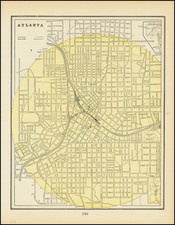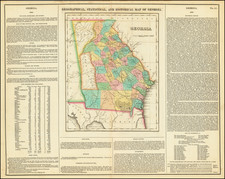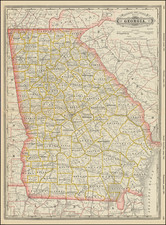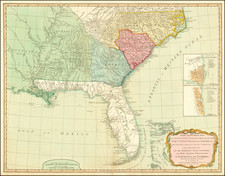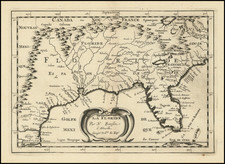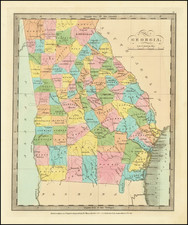Rare Antebellum Wall Map of Georgia.
Handsome hand-colored lithographed wall map of Georgia published by James R. Butts; the largest map of Georgia prior to the Civil War.
Butts's map is drawn on the same scale as William G. Bonner's Map of the state of Georgia compiled under the direction of His Excellency George W. Crawford, engraved in New York by Sherman & Smith and published between 1847 and 1859. Printed by R.L. Barnes in Philadelphia, the map was constructed on 6 sheets and published in only a single edition.
The Butts map was unquestionably a continuation of Bonner's official map, and was updated frequently. As such, this is a very different map than the first (and subsequent) editions of the Bonner.
The map includes vignettes of the following places:
- Capitol at Milledgeville
- Executive Mansion
- Asylum for Lunacy Midway
- Female College, Macon
- Academy for the Blind, Macon
- Stone Mountain
- Franklin College, Athens
- Toccoa Falls
The map also presents a look at the then still active boundary dispute between Florida and Georgia, with 3 separate boundary lines set forth on the map. The 3 lines are:
- The northernmost line, called here the McNeily Line, is the line drawn by D.F. McNeil at the request of the Surveyor General of Florida Territory in 1825.
- The middle line, referenced on the map as "Reported the True Line by J.R. Butts, Surveyor on the part of Georgia 1854".
- The southernmost line, called here Mess. Crawford & Coopers' Line 1831 and Allen's 1854.
The Florida-Georgia Boundary Dispute
The dispute over the boundary between the two states dated back to the Treaty of Paris in 1763, and was intended to have been established by the Treaty of 1795, between the US and Spain (and subsequent 1798-99 Joint Commission, whereby Andrew Ellicott (as US Commissioner) and Stephen Minor (as Spanish Commissioner) set the original boundary (subject to formal survey). Thereafter, several attempts were made by Georgia and Florida to survey the land between 1819 and 1854, without success. The dispute continued until 1857, when the governors of the two states had a conference which resulted in an agreement by which Georgia relinquished its claims to have the eastern terminus of the line changed; and the termini fixed by the commissioners, Ellicott and Minor, were substantially adopted.
The Bonner Map of Georgia
Prior to 1847, the best large format map of Georgia was the Early-Sturges map of 1818. As Georgia grew in population and became increasingly more settled, the Georgia legislature addressed the necessity of an improved large format comprehensive map, which resulted in the retention of William G. Bonner to create such a map. Bonner, a civil engineer, constructed his map by compiling existing material available in Milledgeville and adding information received from county magistrates. As noted in several excerpts from the Macon Weekly Telegraph,
We have witnessed the progression of this work, since its commencement, almost daily. It has been executed at the Capitol, where reference has been easy to the statutes regulating boundary lines, and to all the surveys ever ordered by the State authorities (November 24, 1846).
It appears that Mr. B[onner]. is exceedingly desirous of having a particularly correct outline of each county, with all the public places therein, or whatever may be of local or general interest, noted with care. For this purpose he has furnished a number of counties in the State, through the Executive, with a rough map upon which the Inferior Court were requested to [sic] have dotted and marked the particulars above referred to, and return the same (June 9, 1846).
The resulting map was the largest scale map of Georgia produced to date, emphasizing the state's natural geography and topography. The Georgia-Florida boundary, which was still then in dispute, was indicated by three alternative borders. The dispute was resolved in 1854 by the U.S. Supreme Court, which ruled in favor of Florida, adopting the northernmost, or "McNeil's Line." The map was apparently well received, receiving considerable praise in local newspapers, as well as the backing of the General Assembly, which subscribed to 130 copies of the first edition for distribution to each county and the other states.
The Bonner map was periodically updated over the next decade, with OCLC editions of 1847, 1851, 1854, and 1857, while Phillips' Maps of America adds an 1859 edition at the Library of Congress.
A later revised map of Georgia would be published on a similar scale by A.G. Butts in 1870, 1871, 1882 and 1889.
James R. Butts
James R. Butts served as the Surveyor General of Georgia. He was actively engaged in surveying work in Georgia by the 1840s and held the title of Surveyor General by 1849.
Rarity
The Butts map of Georgia is extremely rare. We have handled three examples including the present map, however, there are no modern auction nor dealer catalog records for the map and the map is apparently not in the Library of Congress nor the Hargett Collection at the University of Georgia.
OCLC locates 5 examples (American Antiquarian Society, Harvard, Boston Public Library, Emory University, and Columbus State University).









